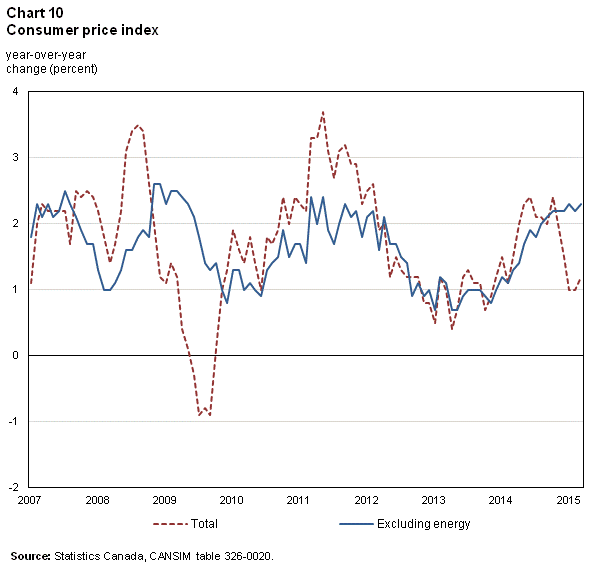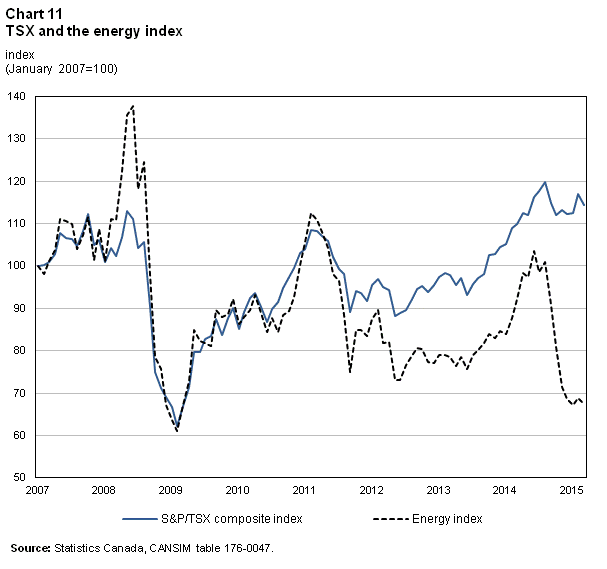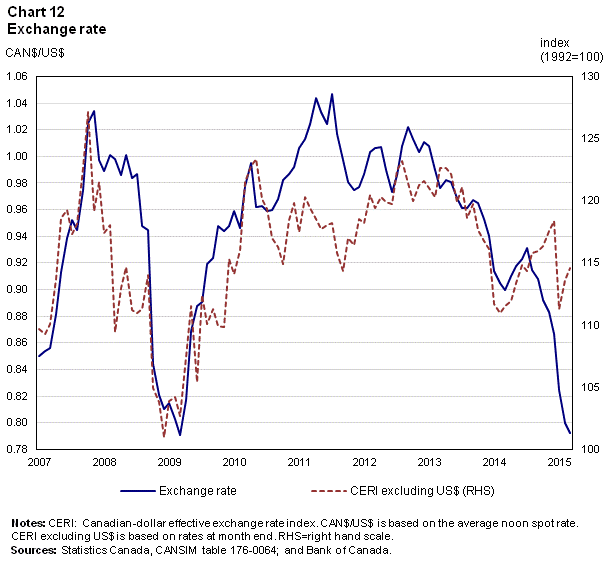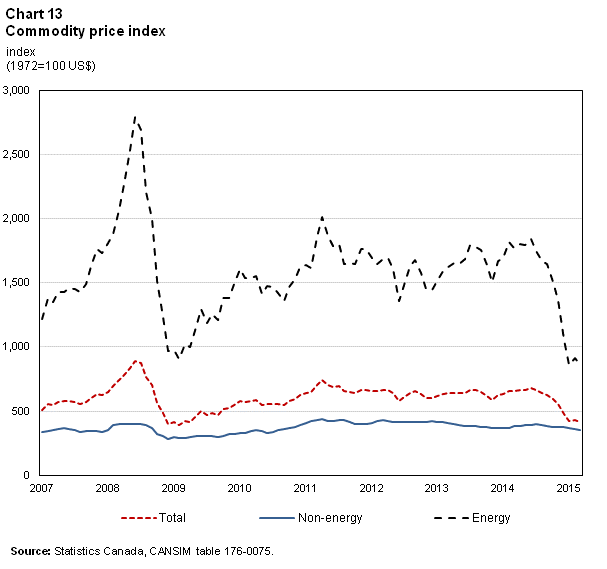Publications
Economic Insights
- 11-626-x no. 043
- Published May 2015
Recent Developments in the Canadian Economy: Spring 2015
Recent Developments in the Canadian Economy: Spring 2015
Archived Content
Information identified as archived is provided for reference, research or recordkeeping purposes. It is not subject to the Government of Canada Web Standards and has not been altered or updated since it was archived. Please "contact us" to request a format other than those available.
by Cyndi Bloskie, Sean Clarke and Guy Gellatly, Analytical Studies Branch
Start of text box
This article in the Economic Insights series provides users with an integrated summary of recent changes in output, employment, household demand, international trade and prices. Organized as a statistical summary of major indicators, the report is designed to inform about recent developments in the Canadian economy, highlighting major changes in the economic data during late 2014 and early 2015. Unless otherwise noted, the tabulations presented in this report are based on seasonally adjusted data available in CANSIM on May 5, 2015.
End of text box

Overview
The decline in oil prices during the second half of 2014 and early 2015 coincided with notable movements in producer and consumer prices, merchandise trade, retail and manufacturing sales, and energy-related sectors. Lower crude and petroleum prices weighed increasingly on raw materials and industrial product prices in late 2014 and early 2015, while headline consumer inflation slowed to 1.5% in December before decelerating to 1.0% in January and February on lower year-over-year gasoline prices. Lower gasoline prices also dampened retail spending.
Crude oil and crude bitumen exports at year end were 33% lower than in June, as the economy posted three consecutive monthly trade deficits to end the year. Crude oil and crude bitumen exports continued to decline in the three months to March, and were 25% lower in March than in December 2014.
Non-conventional oil production increased during the fall of 2014, before declining late in the year. In January, the real output of non-conventional oil extraction industries rose 7.3%, the largest monthly increase since March 2013. Output in this sector in January 2015 was 6.4% higher than in June 2014 before the sharp fall in crude prices. Non-conventional oil extraction increased 2.0% in February.
Overall, the pace of economic growth moderated late in 2014, as exports contracted after making notable contributions to growth in the second and third quarters. Inventories and household spending supported growth in late 2014, as industry output continued to outpace employment creation. After notable gains in September and October, employment remained little changed late in the year. The economy contracted in January on lower output in wholesale, manufacturing and retail industries. Real gross domestic product (GDP) was unchanged in February.

Economic growth moderated on lower exports in late 2014
Real GDP increased 0.6% in the fourth quarter of 2014, following a 0.8% gain in the third. Higher business inventories supported growth late in the year, as auto inventories accumulated in retail industries. Goods exports declined 0.6% in the fourth quarter on lower volumes of motor vehicles, energy products, and farm and intermediate food products. This followed higher export volumes in the third and second quarters (2.7% and 5.1% respectively). For 2014 as a whole, goods exports increased by 6.0%, up from 2.1% in 2013.
Household expenditures increased by 0.5% in the fourth quarter, down slightly from 0.6% in the third. Spending on durables slowed towards the end of the year on lower auto purchases, which had supported household spending in the previous two quarters. Residential investment also moderated towards year end. For 2014 as a whole, household spending increased by 2.8%, compared to 2.5% in 2013.
Non-residential business investment declined in late 2014, on lower investment spending on both structures and machinery and equipment. Investment in structures fell by 0.5% in the fourth quarter, after modest gains in the previous two quarters. Investments in machinery and equipment declined by 0.8% at the end of the year, after advancing 2.2% in the third quarter and 1.3% in the second. For 2014 as a whole, investment in plant and equipment was little changed from 2013.

Business sector labour productivity was little changed in the fourth quarter, following a 0.2% increase in the third. Productivity growth in finance and insurance industries, wholesale trade and mining and oil and gas extraction was offset by declines in retail trade, construction and real estate industries. For 2014 as a whole, labour productivity increased by 2.5%, compared to 1.1% in 2013.
Nominal GDP remained unchanged in late 2014, as lower oil prices affected economy-wide incomes. Nominal GDP expanded by 1.1% in the third quarter, following similar gains in the first half of the year. Lower corporate profits in the final quarter restrained income growth, offsetting a 0.5% gain in wages and salaries.
In the United States, real GDP slowed to 0.5% (quarter-to-quarter) in the final quarter of 2014, less than half the 1.2% growth rate recorded in the third quarter. While consumer spending expanded at the fastest pace in nearly nine years (+1.1%) as employment strengthened, investment slowed, government spending contracted, and net exports weighed on growth. For 2014 as a whole, U.S. real GDP expanded 2.4%, compared to 2.5% in Canada. U.S. GDP slowed further to 0.1% in the first quarter of 2015Note 1 as consumption weakend while exports and fixed investment declined.
Lower goods production in early 2015
Production in the goods sector in Canada increased in three of the last four months of 2014, as output expanded in September and October and again at year end. Manufacturing industries posted higher volumes in these months, and output in December was at its highest level since July 2008. Gains in manufacturing at year end were broad based, led by motor vehicle and machinery manufacturing. The output of goods industries fell in early 2015 with two consecutive declines to start the year. Manufacturing output declined in both January and February.
Petroleum refineries reported lower output in four of the last six months of 2014, with consecutive declines from July to September. On average, monthly production levels at petroleum refineries in the second half of the year were down 2.9% from levels in the first half. Output at petroleum refineries fell in January and February.
Oil and gas extraction industries expanded output in the fall, before ending the year on two consecutive monthly declines as non-conventional oil extraction fell. Non-conventional oil production rebounded in January (+7.3%), offsetting the declines in late 2014. Non-conventional production increased 2.0% in February.
Support activities for mining and oil and gas extraction fell month-over-month from May to September, ending 2014 about 13% below their high for the year. These support activities declined by 10.8% in January and 15.4% in February.
For 2014 as a whole, real output in the goods sector expanded by 2.6%, up from 2.4% in 2013. Production volumes in mining and oil and gas extraction and manufacturing expanded at a faster pace in 2014, while growth slowed in construction industries, utilities and agriculture, fishing and forestry. Overall, annual production in mining and oil and gas extraction increased by 6.6%, up from 3.9% in 2013. Similarly, manufacturing output expanded by 3.0% in 2014, after declining 0.3% in the previous year.

The output of service industries advanced steadily during the second half of 2014, with wholesale industries and finance and insurance industries posting notable gains. Wholesalers made sizable contributions to growth in September and December, led by higher volumes of building supplies and motor vehicles. Finance and insurance industries expanded output through much of the second half of 2014.

Transportation services related to crude oil production increased in the second half of 2014. The average monthly output of crude oil and other pipeline transportation services was 4.8% higher in the last six months of the year. Exports of crude oil and pentanes plus by pipeline also increased in the second half. Net monthly pipeline deliveries of crude oil and pentanes plus for export averaged 12.2 million cubic metres in the six months to December, up from 11.6 million cubic metres during the first six months of 2014.Note 2
For 2014 as a whole, output of service industries increased by 2.3%, up from 2.0% in 2013. Growth was supported by gains in wholesale trade, transportation and retail trade.
Full-time and core-age employment advanced in 2014
While employment growth in 2014 was little changed from the previous year, both full-time work and employment among core-age workers strengthened in 2014 on gains in the second half of the year.
Full time employment-increased by 158,000 in the year, up from 46,000 in 2013. Employment among core-age workers grew by 63,000, offsetting an equivalent decline in the previous year. The number of employees, excluding the self-employed, increased in the second half of 2014, after no net growth during the first six months.

About three-quarters of employment growth in 2014 was in services, notably in health care and social services, and in education industries. Among goods industries, employment increased in construction, and was little changed in manufacturing and resource extraction.

Most of the net increase in employment in 2014 occurred in Western Canada, with Alberta accounting for about half of the December-to-December gain. Both Ontario and Alberta added employment in the second half of the year. While employment in the goods sector strengthened late in 2014, these gains occurred outside of manufacturing and resource extraction.
The overall employment rate (employed individuals as a percentage of the working age population) was little changed in 2014, and has fluctuated between 61 to 62 percent since the 2008/2009 recession. The employment rate among core-age individuals (those aged 25-54) was 81.5% at year end, up slightly from 81.3% in December 2013. It had declined during the first half of 2014, to 80.9% in June, before increasing on employment gains later in the year.
Among the provinces, the employment rate of core-aged workers ranged, at year end, from 76.4% in Newfoundland and Labrador to 85% in Saskatchewan. Employment growth among core-age workers has, in recent years, been much stronger in Western Canada.
Employment rose by 63,000 in the first quarter of 2015 with all of the growth in part-time work. Women and individuals aged 55 and over accounted for the quarterly gain. Private sector employment was unchanged, and employment in goods industries fell by 31,000. Gains were concentrated in education and health care industries. Among the provinces, employment in Quebec rose in the first quarter (+38,000), and was little changed in Ontario (+17,000) and Alberta.
Trade deficits emerged in late 2014 as energy exports declined
Following monthly surpluses from February to September, Canada posted three consecutive monthly trade deficits to end 2014. Merchandise imports exceeded exports by $2.4 billion in the fourth quarter as the surplus for energy products fell to $17.8 billion, down from $20.8 billion in the third quarter. For 2014 as a whole, Canada posted an annual trade surplus of $4.6 billion, after a deficit of $7.2 billion in 2013. The improvement in the annual trade balance was supported by higher energy surpluses early in the year.

Monthly energy exports fell sharply on lower prices during the second half of 2014. At year end, monthly energy exports were $8.3 billion, down 27% from June. Measured in volume terms (in chained 2007 dollars), energy exports at year end were $8.9 billion, equivalent to levels observed in June.

Non-energy exports advanced steadily during 2014, buoyed by higher auto volumes during the spring and early summer, and then again late in the year.Note 3 Total exports of motor vehicles and parts in the second half of the year were $38.7 billion, up from $35.9 billion from January to June. Exports of metal and non-metallic mineral products also increased in the second half.
Exports in January 2015 fell by 1.4% in the month, as both energy (-8.8%) and metals and non-metallic minerals (-8.9%) posted declines. The trade deficit in January widened to $1.8 billion, up from $1.2 billion in December. With export prices down in the second half, the terms of trade declined, hitting a five year low by January 2015.
The economy recorded its fifth consecutive monthly trade deficit in February, as energy exports edged down 0.2%. The trade deficit increased from $2.2 billion in February to $3.0 billion in March, as energy exports declined 8.9%.
Manufacturing sales in the second half of 2014 supported by autos and aerospace
Manufacturing sales advanced by 2.5% in the second half of 2014 on higher shipments of durable goods. Higher sales of transportation equipment and primary metals led growth. Shipments of auto manufacturers were up 9.5% in the second half, on notable gains in July and December. Aerospace products and parts sales rose 11.2%, as sales strengthened late in the year.
Sales of non-durables were down 1.0% in the last six months of 2014, due to lower sales in petroleum and coal product industries. Sales in this industry were down 9.3% in the second half on six consecutive monthly declines. Chemical industries posted lower sales from August to November before increasing at year end.
Manufacturing sales fell in early 2015 with consecutive declines in January (-3.0%) and February (-1.7%). Lower sales of petroleum and coal products, primary metals and transportation products contributed to January’s decline, while lower shipments of motor vehicles and aerospace products accounted for lower manufacturing sales in February.

Lower crude prices weighed on manufacturing input and factory gate prices late in 2014. Industrial product prices, measured year-over-year, rose at a progressively slower pace in the second half of 2014 on lower prices for energy and petroleum products. Industrial product prices fell by 0.4% in the twelve months to December, the first annual decline in the IPPI since October 2013, as prices for energy and petroleum products at year end fell 18.4% year-over-year. In January 2015, industrial product prices declined 2.1% year-over-year, as prices for energy and petroleum products fell 29.1%.
Factory gate prices were more resilient outside of energy and petroleum products, as year-over-year prices strengthened in the second half of 2014. Excluding energy and petroleum, the industrial product price index rose 3.4% in the 12 months to December. Prices for meat, fish and dairy products increased notably since spring 2014, with price gains reaching double digits from July to December. Prices for motor and recreational vehicles strengthened late in the year and into early 2015. Prices for motor and recreational vehicles, measured month-to-month, increased by 3.6% in January, the largest one-month increase in over six years.
Factory gate prices, measured month-to-month, rose by 1.8% in February, led by an 8.8% increase in energy and petroleum products. The year-over-year decline in industrial product prices moderated to 1.5% in February. Factory gate prices declined 1.8% year-over-year in March.
New auto sales set second consecutive annual record
Retail sales were flat or lower in four of the last six months of 2014 with gasoline receipts posting six consecutive monthly declines. By December, gasoline sales fell to the lowest level since early 2011 and were 13.3% lower than their June level.
Demand for autos tapered off at year end, but brisk sales earlier in the year resulted in new auto sales of 1.9 million units for the year as a whole, a second consecutive annual record.
Excluding autos and parts, retail sales retreated in every month in the second half excluding November, when early winter weather boosted demand for clothing and footwear.
Retail spending strengthened in Ontario and British Columbia in the second half, while sales in Alberta fell in each of the last three months of the year.
Retail sales fell 1.4% in January, after declining 1.8% at year end. Lower gasoline receipts and lower sales at motor vehicle and parts dealers contributed to January’s decline. Retail spending rebounded in February, advancing 1.7% on broad-based gains across all sub-sectors. Higher sales at general merchandise stores, gasoline stations and auto dealers supported the increase. Much of February’s growth reflected higher sales in British Columbia, Ontario and Quebec. Sales in Alberta also increased, following four monthly declines.
New housing starts accelerated in second half before slowing in the new year
Housing starts accelerated slightly in the second half of 2014 to a monthly average of 191,200 units (seasonally adjusted at annual rates). For the year as a whole, ground-breaking on new family homes matched the average monthly pace in 2013. Total housing starts slowed in early 2015, declining to 151,200 units in February.
Multi-family urban starts slowed towards year end before rebounding to a 4-month high in January 2015, led by gains in Ontario and Alberta. In February, multi-family starts declined 26%, to their lowest level in two years, primarily due to a pull-back in Ontario. Following a mid-year increase, new construction of single-family urban residences also retreated and slowed further into the new year.
Total starts strengthened in March, increasing to 189,700 after the notable decline in February. Ontario led the increase, as starts rebounded to 62,700 in March, after falling to 42,500 in the previous month. Starts in Alberta and British Columbia also increased.
Residential building permits were little changed during late 2014 before retreating in January then rising slightly in February 2015. New housing prices, measured year-over-year, accelerated to 1.7% towards year end before slowing to 1.4% in January and February.
Building permits declined moderately in February (-0.9%), after decreasing by 12.3% in the previous month. Non-residential permits fell 5.4%, as declines in institutional and commercial permits were partly offset by higher industrial permits. Industrial permits increased in Ontario after two sizable declines in recent months. Industrial permits fell in Alberta, with double digit declines in three of the last four months.
Headline inflation slowed in late 2014 on lower gasoline prices
The pace of inflation slowed in the second half of the year, with consumer prices (before adjusting for seasonality) declining 1.1% in the six months from June to December. Headline All-items inflation remained at or above 2% between April and November, before easing to 1.5% at year end as lower prices for gasoline more than offset higher food costs. In January 2015, the headline rate of inflation slowed further to 1.0%, while the annual change in consumer prices, excluding gasoline, stood at 2.4%. The headline rate remained at 1.0% in February, before rising to 1.2% in the twelve months to March as the downward contribution of lower gasoline prices moderated.

At year end, the gasoline index had fallen 24.6% from its recent peak six months earlier and retreated a further 12.4% on a month-over-month basis in January 2015. In contrast, food prices steadily increased, up 4.6% year-over-year in January, the fastest pace in over three years, led by higher meat prices. Mortgage interest costs continued to have a dampening effect on overall inflation, hitting an eight-year low at year end.
Gasoline prices, measured on a month-to-month basis, increased by 9.4% in February and 6.3% in March.
For 2014 as a whole, headline inflation averaged 2.0%, up from 0.9% in 2013.
Equities fell on lower energy prices before rallying early in 2015
Toronto stock prices (S&P/TSX composite index) fell 6.4% at year-end from their all-time high in August as the energy index tumbled 32% on sharply lower prices for crude oil. By March the overall index had gained 1.8%, supported by a slight rally in energy prices. Gold and materials stocks posted steady declines until rebounding in the new year. The 33% gain for gold in January 2015 was the largest one-month increase since the end of 2008. The diversified metals and mining index steadily retreated on lower prices for metals such as copper, aluminum and iron ore, but rallied by 20% in February, the fastest pace in 40 months.

Stocks related to consumer demand, such as consumer staples and discretionary indices, steadily advanced over the second half of 2014, offsetting the downward pressure from energy and metals. Overall, the TSX increased 0.3% in January 2015 and a further 3.8% in February before falling back 2.2% in March.
The Canadian dollar depreciated against the U.S. dollar throughout the second half of 2014. From a recent peak of 93.1 cents in July, the dollar depreciated to 86.7 cents by December, before falling to 79.2 cents by March. Conversely, the Canadian dollar appreciated against the currencies of other major trading partners throughout 2014, before depreciating in early 2015.

Broad-based declines in commodity prices
Commodity prices fell in each of the last six months of 2014 and further into the new year, offsetting gains earlier in 2014. By January 2015, the commodity price index had retreated 38% from its June peak, and was at its lowest level since the spring of 2009. Energy prices led the decline, dropping 53% over the same time period in line with sharply lower worldwide prices for crude oil. In February 2015, the total commodity price index increased by 1.5%. The overall year-over-year decline of 35%, however, was the largest since July 2009.
Excluding energy, commodity prices were down 9.4% to February 2015 from their recent July peak, as prices declined across all the major indexes including metals and minerals, agriculture, forestry and fish. The commodity price index fell 3.1% in March.

Credit market debt to disposable income reached record high in late 2014
Household credit market debt reached $1.82 trillion in the fourth quarter of 2014, up from $1.80 trillion in the third quarter.Note 4 Credit market debt to disposable income rose to a record high of 163.3% in the fourth quarter, from 162.7% in the third, while the debt service ratio held steady at 6.8% over this period.
Household assets rose to $10.17 trillion in the fourth quarter, up from $10.08 trillion in the third. Household net worth —assets minus liabilities — reached $8.32 trillion in the fourth quarter, up from $8.25 trillion in the third. Growth in household net worth moderated in the second half of 2014.
Notes
- Date modified:
